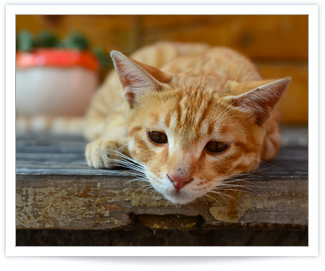 Does your cat seem to be losing weight? Are they fatigued or constantly thirsty? Your cat may be suffering from a disorder called feline hyperthyroidism. This is where their body is producing too much thyroid hormone, which could lead to a wide variety of serious health issues if left untreated. If ignored, hyperthyroidism can cause organ failure and even death.
Does your cat seem to be losing weight? Are they fatigued or constantly thirsty? Your cat may be suffering from a disorder called feline hyperthyroidism. This is where their body is producing too much thyroid hormone, which could lead to a wide variety of serious health issues if left untreated. If ignored, hyperthyroidism can cause organ failure and even death.
Often, cats only exhibit signs of hyperthyroidism when it has already been affecting them for several years. This disorder can begin at an early age but may not show symptoms until your cat is about 12 years old. However, there is a way you can test your cat for hyperthyroidism before it is too late. An easy way to determine if your cat is suffering from hyperthyroidism is with a simple blood test by your veterinarian at one of our treatment facilities.
Feline hyperthyroidism cost can vary depending on your method of treatment. While some ongoing treatments such as medication or dietary restrictions may seem more affordable, they will need to be maintained for the duration of your cat’s lifetime. This could mean astronomical costs over the years. Radioactive treatment is a more expensive option up front, but it is more effective and will likely only need one or two rounds of treatment. Consult with your veterinarian to find out more information about feline hyperthyroidism costs.
What is feline hyperthyroidism?
Feline hyperthyroidism is a disorder that affects some cats around the age of 12-14. It is caused by the over secretion of the thyroid hormone in abnormal thyroid cells. These cells are in one or both thyroid glands, which can be found in your cat’s neck. This increase in thyroid hormone levels cause an increase in metabolism. An increased metabolism can make your cats begin to exhibit signs of weight loss, appetite changes, heightened thirst, elevated blood pressure, heart murmur, increased vocalization, fatigue, fur loss, and abnormal behavior.
Feline hyperthyroidism is a gradual process that takes several months to start to appear, though it may be causing damage to your cat’s health long before you are aware of its existence. If left untreated, an increased metabolism can lead to organ failure and even death.
Your veterinarian can detect if your cat is suffering from feline hyperthyroidism with a simple blood test. This is the best way to understand your pet’s health rather than a physical examination. If your cat’s hyperthyroidism is detected by a physical exam, that may be a sign that the disease has progressed to dangerous levels. After a long period of time, hyperthyroidism can lead to obvious physical signs such as the swelling of organs, and inflammatory bowel disease. Your veterinarian may decide to perform a radiograph or cardiac ultrasonography.
There are a few ways to treat hyperthyroidism. The course of treatment may vary based on the cat’s age or the severity of their condition.
Medication
There are a few medicinal ways to treat feline hyperthyroidism both with oral medications and transdermal antithyroid medications. These medications can help manage the excessive secretion of your cat’s thyroid hormones. However, this is not a perfect science. Medications will be necessary for the rest of your cat’s life and will likely be very expensive as the years go by. These medications can also have serious side effects such as loss of appetite, vomiting, liver failure, allergies, and bone marrow suppression. Managing this medication will require regular visits to your veterinarian to have bloodwork testing performed. This will mean your cat will need to have blood work performed every 6 months. This is considered to be the most expensive option for treating feline hyperthyroidism.
Nutrition
An iodine restriction diet can help to treat feline hyperthyroidism, but it must be followed precisely for it to be effective. This treatment will be ineffective if the cat does not follow the diet exactly.
Surgery
Surgical treatment for feline hyperthyroidism can come with some serious risk, but it can also be highly effective. Every surgery comes with risk if it involves the use of general anesthesia or sedation. About 10-20% of cats do develop feline hyperthyroidism again years after surgery. This option may be necessary for cats with thyroid glands that are about 3-4 centimeters in width before they can move on with any other form of treatment.
Radioactive Therapy
Radiation therapy uses a radioactive isotope of iodine that is injected underneath the skin like a vaccine. The isotope will be concentrated in the most active thyroid cells that are secreting the excess thyroid hormone. This will likely cause the abnormal thyroid cells to “die”. Radioactive therapy does not require anesthesia; however, it will require your cat to remain in isolation for some time after treatment. It may take about three to four days for the radiation to wear off before your cat can safely return home. This is the most effective way to treat feline hyperthyroidism and can cure the disorder in about 98% of cases. Consult with your veterinarian to find out more about radioactive treatment for feline hyperthyroidism.
Consult our team at Thyro-Cat today to learn more about feline hyperthyroidism and the proper treatment for your cat. No two animals are the same, so treatment should be designed specifically to your cat’s needs. Call (866) 467-8228 today to learn more about your cat’s health and how you can best care for your pet.